FIGURE 7.
Recruitment of neutrophils i.p. following LL-37 administration reduces spore burden in Mac-1+ cells and increases spore clearance. Mice were injected i.p. with PBS or peptides as described in Fig. 6 and after a 4-h incubation, 1 × 107 Alexa Fluor 555-labeled spores were injected i.p. Peritoneal lavages were performed 1 h later, and cells were subsequently stained for cytospin analysis or plated to determine spore survival. Graph values are pooled from three experiments. A, Representative photomicrographs of cytospins prepared from the PECs collected from PBS-treated mice illustrating differential staining that allows intracellular spores (red only) to be distinguished from extracellular spores (green and red) within Mac-1+ cells (white) and the total cell population (phase and Hoechst). Bars, 20 µm. B, Intracellular spore burden was determined from 300 randomly selected cells from cytospins shown in A by counting the number of Alexa Fluor 555-labeled spores (red) that did not costain with the Alexa Fluor 488-labeled anti-BclA mAb (EF12; green). Values represent the mean number of intracellular spores per Mac-1+ peritoneal cell ± SEM. Statistical significance was determined with a one-way ANOVA and Dunnett posttest. n = 5 mice per group. C, Aliquots of 1 × 105 cells from each mouse were lysed, serially diluted, and plated overnight. The percent recovered was calculated by normalizing the number of CFU quantitated from PBS-pretreated mice to 100% for each experimental repetition. Values represent the mean percentages ± SEM. n = 9 mice per group. *, p < 0.05; **, p < 0.01; ***, p < 0.001.

